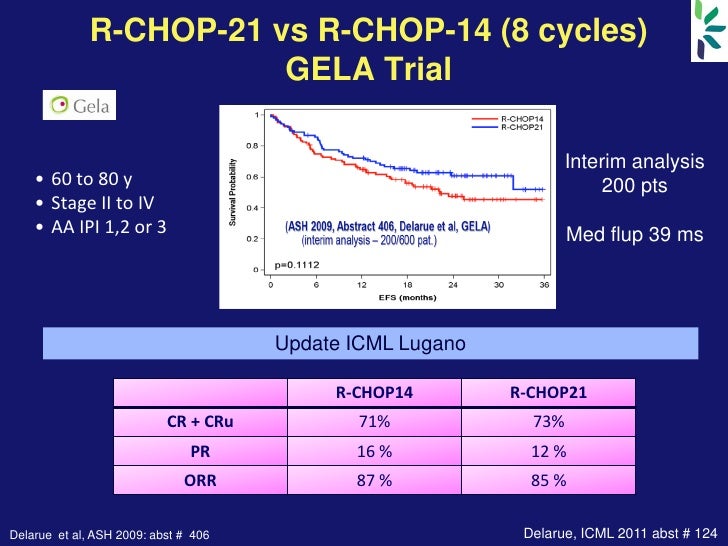
Thus, today’s clinician has to walk the line between efficacy and tolerability for a disease in which many issues remain to be resolved with respect to aetiology, pathology and treatment. Compounding this challenge, more than half of the patients diagnosed with DLBCL are over 60 years of age.

However, despite recent advances in the classification and molecular profiling of the disease, its biological heterogeneity still hampers diagnosis, prognosis and treatment. Today, the addition of monoclonal antibodies such as rituximab (R) has altered the therapeutic landscape and improved clinical outcomes. Patients typically present with nodal or extranodal disease, usually exhibiting rapid tumour growth and symptoms that are highly dependent upon the tumour localisation.įor over 25 years, the CHOP (cyclophosphamide, doxorubicin, vincristine and prednisone) regimen was the gold standard for the treatment of DLBCL. This heterogeneous disease has a complex classification, and if left untreated, takes an aggressive and fatal clinical course. In the Western world, nearly 90% of aggressive mature B-cell lymphomas are identified as DLBCL. Rituximab, first-line treatment, maintenance treatment, follow-up, DLBCL, relapsed/refractory disease, chemotherapy, stagingĭiffuse large B-cell lymphoma (DLBCL) is the most frequently-occurring lymphoma, accounting for an estimated 35% of all lymphoma cases worldwide.

Unfolder trial trial#
This review outlines some of the current treatment strategies for DLBCL and discusses the main issues that affect clinical practice.ĪaIPI = age-adjusted International Prognostic Index ABC = activated B-cell – like ACVBP = doxorubicin, cyclophosphamide, vincristine, bleomycin and prednisone ASCO = American Society of Clinical Oncology BCCA = British Columbia Cancer Agency CALGB = Cancer and Leukaemia Group B CEPP = cyclophosphamide, etoposide, procarbazine and prednisone CHOEP = cyclophosphamide, doxorubicin, vincristine, etoposide and prednisone CHOP = cyclophosphamide, doxorubicin, vincristine and prednisone CNS = central nervous system CORAL = Collaborative Trial in Relapsed Aggressive Lymphoma CR = complete response CT = computerised tomography DFS = disease-free survival DLBCL = diffuse large B-cell lymphoma DSHNHL = German High-Grade Non-Hodgkin's Lymphoma Study Group EFS = event-free survival EORTC = European Organization for Research and Treatment of Cancer ESHAP = etoposide, solumedrol, high-dose cytarabine and platinum EPOCH = etoposide, prednisone, vincristine, cyclophosphamide and doxorubicin ESMO = European Society for Medical Oncology FIL = Italian Lymphoma Foundation FISH = fluorescence in-situ hybridisation GCB = germinal centre B-cell – like G-CSF = granulocyte colony-stimulating factor GELA = Groupe d'Etude des Lymphomes de l'Adulte HDT = high dose therapy HIV = human immunodeficiency virus ICE = ifosfamide, carboplatin and etoposide IFRT = involved-field radiation therapy IPI = International Prognostic Index LDH = lactate dehydrogenase MInT = MabThera International Trial NCCN = National Comprehensive Cancer Network NHL = Non-Hodgkin’s lymphoma NOS = not otherwise specified OS = overall survival PET = positron emission tomography PMBL = primary mediastinal B-cell lymphoma PFS = progression-free survival R = rituximab RICOVER-60 = Rituximab with CHOP over age 60 years SCT = stem cell transplantation SAKK = Schweizerische Arbeitsgruppe für Klinische Krebsforschung SWOG = Southwest Oncology Group WHO = World Health Organisation. Despite remarkable progress in improving patient survival, clinical outcomes are still unsatisfactory for certain subsets of patients, including the elderly and very elderly and those with highly aggressive disease. Immunochemotherapy regimens, consisting of the anti-CD20 antibody rituximab typically in combination with cyclophosphamide, doxorubicin, vincristine and prednisone (CHOP), are currently the treatment backbone. It has an aggressive natural history, with a median survival of less than one year if left untreated.

Please find the affiliations for this article in the PDF.ĭiffuse large B-cell lymphoma (DLBCL) is the most frequently-occurring type of malignant lymphoma in the Western world.


 0 kommentar(er)
0 kommentar(er)
